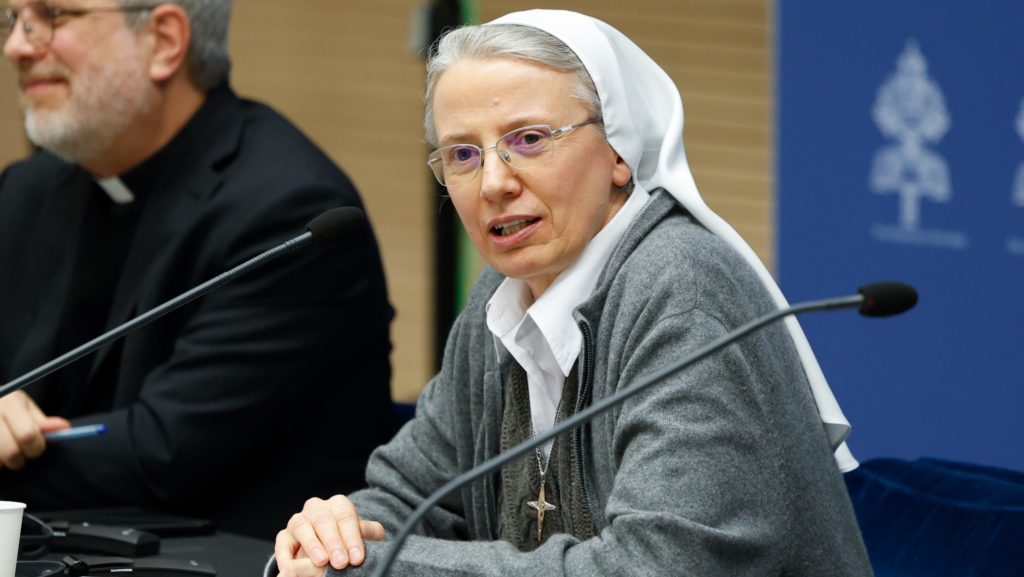As with any papal transition, when Pope Leo XIV was elected questions arose about what his priorities would be, and whether he would continue to advance the priorities and reforms of his predecessor.
One of the most consistent questions up to now, as the world is getting to know Pope Leo, has been what his approach to women will be, and whether he will continue Pope Francis’s trailblazing efforts to create more meaningful spaces for them in governance and authority, including within the Roman Curia.
What Leo will do on issues such as women’s priestly ordination and the women’s diaconate remain to be seen, however, he was a participant in Francis’s Synod on Synodality, which led to the formation of several study groups focusing on specific issues, including one on ministries and the possibility of the women’s diaconate.
At the start of the 2024 Synod on Synodality, Argentine Cardinal Víctor Manuel Fernández, prefect of the Vatican’s Dicastery for the Doctrine of the Faith (DDF), who is in charge of the study group exploring the women’s diaconate, said it was premature to make any sort of decision on the issue, and that it would continue to be studied.
It is unlikely the new pope will make any dramatic moves on this or women’s ordination right at the beginning of his pontificate, but he’ll probably wait to see what the study groups say, as they are expected to complete their first mandate and summarize findings by June of this year.
Even then, it is unlikely he will deviate from the line taken by his predecessor on issues such as women’s priestly ordination, which Francis repeatedly said was a solidly closed door.
In the meantime, Pope Leo has already sent some initial signals that he will maintain the status quo for the women Francis already placed in leadership and expand their presence in the Roman Curia.
Without overinterpreting, within the first few days after his election Pope Leo XIV had a private meeting with Italian Sister Simona Brambilla, whom Francis in January had named prefect of the Vatican’s Dicastery for Religious.
The appointment, marking the first time a woman had been named to lead a Vatican department, caused a stir among canonical rigorists, who took issue with the fact that she was not ordained, as some of her work as prefect involves making binding decisions on members of Holy Orders.
In a nutshell, the argument is that dicastery prefects share in the authority of the pope, governing in his name and as an extension of papal power as rooted in Holy Orders and apostolic succession, which is not open to women.
Francis sought to change this during the later years of his papacy, seeking with his curial reforms to separate Holy Orders from governance by placing more competent laypeople in positions of authority.
Many observers wondered whether Brambilla and Italian Sister Raffaella Petrini, head of the Vatican City Governorate, would be kept in their positions by Pope Leo given the debate over canonical nuances, and it seems that for the time being, Leo is not only intent to do so, but he is doubling down on the inclusion of women in top curial positions.
He decided at the beginning that he would leave all dicastery prefects and heads of Vatican departments in their current roles while he gets to know them and receives summaries of their work.
Not only did Pope Leo meet almost immediately with Brambilla, but during his first public general audience May 21, nearly all of the lectors who did the Gospel reading and summaries of his catechesis in different languages were women, with the exception of the Arabic-language lector.
Until recently, the readers were all men, usually clergy, however, Pope Francis began a shift in this regard and allowed lay people generally, including women, to do the readings during the general audiences.
On Thursday, May 22, Leo made his first significant curial appointment, notably naming Italian Sister Tiziana Merletti, former superior general of the Franciscan Sisters of the Poor, as secretary of the Dicastery for Religious, meaning the top two positions in that department are now occupied by women.
Sandwiched in between the two is Spanish Cardinal Ángel Fernández Artime, appointed by Pope Francis as pro-prefect alongside Brambilla as prefect, a move interpreted by many observers as a clear signal that Brambilla was in charge, but that Artime’s signature would eliminate debate over the validity of her decisions.
Merletti, a canon lawyer, is now the third woman to occupy the post of secretary of a Vatican dicastery, after Brambilla’s initial appointment as secretary of the Dicastery for Religious before her promotion to prefect, and that of Sister Alessandra Smerilli as secretary of the Dicastery for Integral Human Development.
Pope Francis in his apostolic constitution reforming the Roman Curia Predicate Evangelium, authorized laypeople, including women, to lead Vatican departments, whereas the positions had previously been open only to men.
Born in Pineto in central Italy in 1959, Merletti made her first religious profession with the Franciscan Sisters of the Poor in 1986.
She earned a law degree in 1984, and in 1992 obtained a doctorate in canon law from the Pontifical Antonianum University in Rome. She currently works as a canon lawyer with the International Union of Superiors General, an umbrella organization for women religious worldwide.
During Pope Francis’s papacy, the ratio of women working in the Holy See and Vatican City rose from 19.2 percent to 23.4 percent, with many in positions of authority.
If his early moves are any indication, it seems that Pope Leo XIV, in addition to carrying forward an emphasis on the Church’s social agenda, is also intent on securing women’s places and voices at the apex of the Catholic Church’s global governing bureaucracy.

